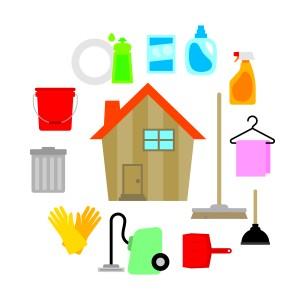 The following message comes from Toxics Use Reduction Institute at the University of Massachusetts Lowell.
The following message comes from Toxics Use Reduction Institute at the University of Massachusetts Lowell.
If you don’t use a toxic chemical in the first place, then you don’t have to contain it, clean it up, or be exposed to it—which is what preventing pollution is all about. Follow these tips to reduce your exposure to toxic chemicals and create a safer and healthier indoor living environment for you and your family.
1) Household Cleaners: Look for labels that divulge ALL of the cleaner’s chemicals. Besure to avoid using cleaners that contain these suspect hormone disrupter chemicals:Nonyl- and octyl-phenols are used to make alkylphenol ethoxylate (APE) detergents.
2) Disinfectants. Limit the use of disinfecting products in your home. They contain chemical agents that are capable of destroying or inhibiting the growth of microorganisms. Overuse could lead to the growth of ‘superbugs.’ The Environmental Protection Agency (EPA) classifies disinfectants and anti-microbials as pesticides.
3) Lawn Care and Pests: Children and pets in particular are exposed to pesticides tracked inside homes from lawn treatments. Pesticide exposure also occurs from using off-the shelf pest repellents. Use organic lawn care methods like mowing high and adding topsoil. To get rid of pests, remove food sources, use boric acid and traps.
4) Vinyl Floor and Wall Coverings: Flexible vinyl household products like flooring and wallpaper are manufactured using PVC that may have toxic chemical additives including phthalate plasticizers and lead. As these products are used, they create dusts that accumulate these chemicals. Choose non-PVC wall and floor coverings to minimize potential exposure to these toxins.
5) Building Materials: Plywood, oriented strand board, kitchen cabinets and home insulation are all products that can contain formaldehyde, a known human cancer causing chemical. Choose solid woods and formaldehyde-free insulations when constructing or renovating your home.
6) Personal Care and Beauty Products: Choose products that are fragrance free and reduce your use of nail polish and acetone nail polish remover. If you do use these products, be sure to open your windows.
7) Dry Cleaning: Ask your dry cleaner if they offer safer alternatives such as liquidcarbon dioxide or “wet cleaning” rather than the commonly used cleanerperchloroethylene, a suspected cancer-causing chemical.
8) Got Moths?: Eliminate the use of mothballs since they contain naphthalene or paradichlorobenzene. Instead, clean and seal wool clothes, use cedar blocks, shavings or oil.
9) Mold: Dry is the operative word. Prevent mold and the overuse of bleach by preventing moisture build up in the first place. Fix leaky pipes and faucets immediately. Make sure that water slopes away from the foundation of your home.
10) Basement: Do not leave a car running even with the garage door open especially if the garage is under the living area. Carbon monoxide can easily seep through walls and floors. When your oil company calls during the slow summer months to clean your boiler, don’t delay. And test your house for radon.


